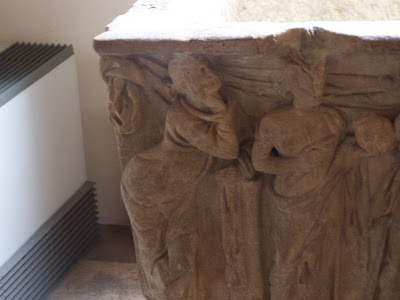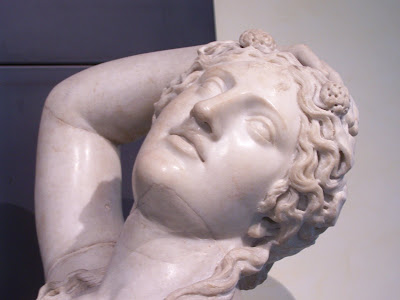1.) Funerary urn of Julius Venustus. 2nd Century AD.
2 winged cupids on the sides hold grape vines and fruit. A griffon is on the top of the urn approaching a serpent. Eagles and birds are on the bottom. I thought the presence of an urn was interesting in relation to sarcophagi. It also depicts fertility scenes, such as cupids on the sides.



2.) This sarcophagus was difficult to photograph and is not in the best condition, however it shows a Shepard scene with little cupids, lambs on top. There is fluting for the main frieze. To the left is a veiled figure, perhaps an Orans figure, and to te right is a Shepard carrying sheep. Dionysus was a pastoral god who represented fertility, while he is not present this sarcophagus shows the importance of the growing trend in displaying pastoral scenes in funerary art.




3.) This is a sarcophagus of the 9 muses. The theatre mask is very evident to the right of the frieze. 2 people are to the right and a bearded man is to the very left who looks very similar to Silenus from other artwork I have seen.. A man stands at the center of the muses, perhaps Dionysus. Crosses are on the sides of the sarcophagus. If this is a Dionysian sarcophagus the presence of crosses on the sides is something new I have not seen before. If it is not the combination of Christian and pagan iconography is something to be noted.





4.) Torso of Dionysus
160-200 BC. The torso might have been half lying on a chariot, usually thought to be for the Indian triumph. Dionysus is shown with grape vines in his hair, in a very relaxed position.


5.) This Sarcophagus shows chubby cupids with vines in their hair as well as animals and flowers. It is a sign of fertility as well as usually interpreted with Dionysus.

While the actual presence of Dionysus in the sarcophagi was hard to find in this museum there was a continual presence of fertility involving animals, shepards, cupids, and vines. All things that are directly related to the god.


 2.) This sarcophagus was difficult to photograph and is not in the best condition, however it shows a Shepard scene with little cupids, lambs on top. There is fluting for the main frieze. To the left is a veiled figure, perhaps an Orans figure, and to te right is a Shepard carrying sheep. Dionysus was a pastoral god who represented fertility, while he is not present this sarcophagus shows the importance of the growing trend in displaying pastoral scenes in funerary art.
2.) This sarcophagus was difficult to photograph and is not in the best condition, however it shows a Shepard scene with little cupids, lambs on top. There is fluting for the main frieze. To the left is a veiled figure, perhaps an Orans figure, and to te right is a Shepard carrying sheep. Dionysus was a pastoral god who represented fertility, while he is not present this sarcophagus shows the importance of the growing trend in displaying pastoral scenes in funerary art.



 3.) This is a sarcophagus of the 9 muses. The theatre mask is very evident to the right of the frieze. 2 people are to the right and a bearded man is to the very left who looks very similar to Silenus from other artwork I have seen.. A man stands at the center of the muses, perhaps Dionysus. Crosses are on the sides of the sarcophagus. If this is a Dionysian sarcophagus the presence of crosses on the sides is something new I have not seen before. If it is not the combination of Christian and pagan iconography is something to be noted.
3.) This is a sarcophagus of the 9 muses. The theatre mask is very evident to the right of the frieze. 2 people are to the right and a bearded man is to the very left who looks very similar to Silenus from other artwork I have seen.. A man stands at the center of the muses, perhaps Dionysus. Crosses are on the sides of the sarcophagus. If this is a Dionysian sarcophagus the presence of crosses on the sides is something new I have not seen before. If it is not the combination of Christian and pagan iconography is something to be noted.




 4.) Torso of Dionysus
160-200 BC. The torso might have been half lying on a chariot, usually thought to be for the Indian triumph. Dionysus is shown with grape vines in his hair, in a very relaxed position.
4.) Torso of Dionysus
160-200 BC. The torso might have been half lying on a chariot, usually thought to be for the Indian triumph. Dionysus is shown with grape vines in his hair, in a very relaxed position.

 5.) This Sarcophagus shows chubby cupids with vines in their hair as well as animals and flowers. It is a sign of fertility as well as usually interpreted with Dionysus.
5.) This Sarcophagus shows chubby cupids with vines in their hair as well as animals and flowers. It is a sign of fertility as well as usually interpreted with Dionysus.
 While the actual presence of Dionysus in the sarcophagi was hard to find in this museum there was a continual presence of fertility involving animals, shepards, cupids, and vines. All things that are directly related to the god.
While the actual presence of Dionysus in the sarcophagi was hard to find in this museum there was a continual presence of fertility involving animals, shepards, cupids, and vines. All things that are directly related to the god.
No comments:
Post a Comment